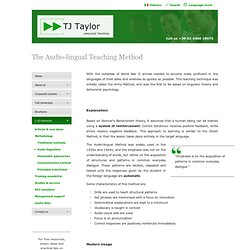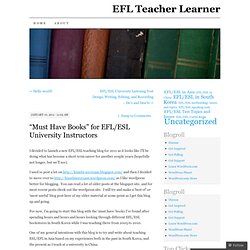

What's the future of English? Linguistics expert David Crystal is in Russia to give a series of lectures.

At the UK-Russia Linguistic Symposium at the Russian State University for the Humanities in Moscow, he described ‘the future of Englishes’ and the evolution of global varieties of English across the world. Keira Ives-Keeler of the British Council in Russia explains. Advertising campaigns give an insight into how languages evolve. English Language Teaching Methodologies. With the outbreak of World War II armies needed to become orally proficient in the languages of their allies and enemies as quickly as possible.

This teaching technique was initially called the Army Method, and was the first to be based on linguistic theory and behavioral psychology. Explanation Based on Skinner's Behaviorism theory, it assumed that a human being can be trained using a system of reinforcement. Correct behaviour receives positive feedback, while errors receive negative feedback.
This approach to learning is similar to the Direct Method, in that the lesson takes place entirely in the target language. "Emphasis is on the acquisition of patterns in common everyday dialogue. " The Audio-lingual Method was widely used in the 1950s and 1960s, and the emphasis was not on the understanding of words, but rather on the acquisition of structures and patterns in common everyday dialogue. Some characteristics of this method are: Modern Usage Developments & Problems. Humanising Language Teaching Magazine for teachers and teacher trainers. Online Conference 2013. November 2013. 8 Ideas for the 8 Multiple Intelligences by Lou McLaughlin Not all students learn in the same way.

Therefore, it is important that each learning style is catered to, and the onus is on the teacher to add variation in approach and instruction. The incorporation of multiple intelligence (MI) allows us to explore the ways in which each child learns best. This knowledge can assist teachers in classifying the instructions and learning activities they are using to achieve their objectives. The following learning styles have been broken down based on Gardner’s MI theory (2003) and using Bloom’s taxonomy. Note: The activities here can be used with any topic or language point in the English language classroom. 1. 2. Debates: Set these up based on the issue being studied.Example: Put students in groups to prepare arguments for and against a motion, such as “Students should learn two foreign languages.”Giving feedback: Respond to ideas forwarded by other groups during project work. 3. 4. 5. 6. 7. Teachers' workload: tips on how to manage it and get a work-life balance.
So what advice can I offer teachers who struggle to find a healthy work-life balance?

Well, in writing this I'm conscious that I'm not exactly in a position to preach, just ask my family. But obviously enough it comes down to being efficient with the time you devote to your teaching and making sure you have plenty going on away from work. However, that is easier said than done and over the years I have found that some common workload issues arise. Marking overload I've seen too many teachers crushed by expectations that they'll review and comment on all their students' work. Planning pressure When teachers experience overload I often find that they are over-planning their lessons or trying to generate too many resources themselves.
Report deadline pile-up Reports can be another killer. Over-commitment. “Must Have Books” for EFL/ESL University Instructors. I decided to launch a new EFL/ESL teaching blog for 2011 as it looks like I’ll be doing what has become a short term career for another couple years (hopefully not longer, but we’ll see).

I used to post a lot on and then I decided to move over to as I like wordpress better for blogging. You can read a lot of older posts at the blogspot site, and for most recent posts check out the wordpress site. I will try and make a ‘best of’ or ‘most useful’ blog post here of my older material at some point as I get this blog up and going.
For now, I’m going to start this blog with the ‘must have’ books I’ve found after spending hours and hours and hours looking through different EFL/ESL bookstores in South Korea while I was teaching there from 2005 to 2010. One of my general intentions with this blog is to try and write about teaching ESL/EFL in Asia based on my experiences both in the past in South Korea, and the present as I teach at a university in China. Well, that’s about it for now. p.s. Why has the lexical approach been so long in coming? Put your words together ... language is made up of common word phrases which are the key to teaching, according to the seminal work of linguist Michael Lewis 20 years ago.

Photograph: Khaled Abdullah/Reuters Twenty years after the publication of Michael Lewis's seminal book The Lexical approach: The state of ELT and a way forward, the bold prophecy of the title remains unfulfilled. A quick glance at any commercially available EFL textbook reveals that a traditional grammar syllabus, the main object of Lewis's attack, is still alive and kicking, albeit more cleverly disguised. How come Lewis's ideas have not been eagerly taken up by the mainstream English Language Teaching (ELT)? Insights from research take a notoriously long time to seep into the teaching practice for all kinds of reasons. Deliberately written in a non-academic, teacher-friendly style, Lewis's 1993 volume was an attempt to introduce fascinating insights from corpus linguistics into the classroom practice.